Study for Talmont
Ellsworth Kelly American
Not on view
This monumental sketch marks a distinct innovation in Kelly’s early work at a moment when he began his experimental approach to composition. In 1951, the artist dreamt that he "was working on a scaffold… creating an immense mural composed of square panels on which we painted black bands with huge brushes."[1] With this vision in mind, he cut up drawings of stark black lines into squares, rearranged them into grids by chance, and then translated them into painted compositions that followed the preparatory collages. That summer, while in the seaside town of Meschers, France, he continued to elaborate on compositions based on these operations. In the largest of these canvases, Talmont, painted upon his return to Paris that autumn, Kelly reduced the number of squares to ten, making them simultaneously grander and less dense. Yve-Alain Bois, author of the artist’s catalogue raisonné, notes that the translation from a small collage just nine inches high to the final painted version of Talmont necessitated a middle step, this study, made at exactly the size of the finished painting, a confident maquette ready to assume a scale approaching the majestic.
[1] Ellsworth Kelly et al. Ellsworth Kelly: The Years in France, 1948–1954, Washington, D.C.: National Gallery of Art, 1992, p. 190.
This image cannot be enlarged, viewed at full screen, or downloaded.
